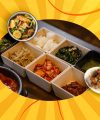Table Of Content
I first tried making bibimbap when I was at my university. Fascinated with the colorful meal that I often see in K-Dramas, I wanted to know what it really tastes like.
TBH, the trend of food bowls has grown exponentially in the past few years. There are certain restaurants that have even made these their concept. What many people do not know about is the fact that this trend actually started in parts of Asia.
If you have been trying to make a colorful rice bowl, this is your sign! Therefore, keep reading till the end to learn about the best ways of making bibimbap.
What Is Bibimbap?

Before talking about how to make this Korean dish and what I thought about it, let me explain what bibimbap is in the first place!
To put it in simple words, bibimbap is a popular Korean dish that translates to “mixed rice.”
It typically consists of a bowl of warm white rice topped with an assortment of seasoned vegetables (called namul), sliced meat (often beef or chicken), a fried or raw egg, and gochujang (Korean chili paste) for flavor.
The dish is mixed thoroughly before eating, combining the ingredients and flavors. Additinoally, it can also be served vegetarian or vegan by omitting the meat and egg.
What attracted me to this dish was its colorful presentation and balance of flavors and textures. However, what I realised soon was how nutritious this dish is.
But was it always this popular? The answer is a little tricky. So let me tell you something interesting about the evolution of this Korean staple.
History Of Bibimbap

Bibimbap, a quintessential Korean dish, has a rich history dating back to the Joseon Dynasty (1392–1910).
Initially, it was known as “goldongban,” referring to mixed rice with various ingredients, often made from leftovers after ancestral rites (jesa). This practice minimized waste and reflected the resourcefulness of Korean households.
During the Joseon era, bibimbap became more refined. People would serve it in royal courts with high-quality ingredients arranged artfully, emphasizing Confucian ideals of harmony and balance.
Eventually, commoners adapted the dish using seasonal vegetables and leftovers, leading to diverse regional variations such as Jeonju bibimbap, known for its premium ingredients.
In the 20th century, urbanization transformed bibimbap into a convenient meal for busy city dwellers. The introduction of dolsot bibimbap served in a hot stone pot, added a crispy texture and enhanced its appeal.
As Korea modernized and globalization increased, bibimbap gained international recognition. Gradually, it became a symbol of Korean culture.
Today, it is celebrated worldwide for its nutritional balance and adaptability, showcasing the evolution of a dish that beautifully marries tradition with contemporary dining trends.
How To Make Bibimbap?

If you have never made bibimbap before, there is no need for you to worry. Rather, I can assure you that it is probably one of the easiest Korean dishes that you can make. Here is a step-by-step guide to making the best bibimbap at home:
| Time to Cook | 45 minutes to 1 hour |
Ingredients
Here’s what you’ll need to create an authentic bowl of bibimbap. Adjust quantities to suit the number of servings.
For the Rice:
- 2 cups of cooked white rice (or brown rice for a healthier option)
For the Vegetables (Namul):
- spinach, blanched and squeezed: 1 cup
- carrot, julienned: 1 small
- zucchini, julienned: 1 who
- 5-6 shiitake mushrooms, thinly sliced
- 100g bean sprouts, blanched
For the Protein:
- beef (or chicken/tofu for a vegetarian option), thinly sliced: 200g
- soy sauce: 1 tablespoon
- sesame oil: 1 teaspoon
- sugar: 1 teaspoon
- garlic, minced: 1 clove
For the Toppings:
- 2 eggs (fried sunny-side up or raw, depending on preference)
- Sesame seeds (for garnish)
- Kimchi (optional, for an extra punch)
For the Sauce:
- 2 tablespoons gochujang (Korean chili paste)
- sesame oil: 1 teaspoon
- sugar: 1 teaspoon
- rice vinegar: 1 teaspoon
Preparation
Here are the steps that you need to follow:
Cook the Rice:
Start by cooking your rice until it’s fluffy. Use a rice cooker or cook it on the stove, ensuring it doesn’t get too sticky. Keep it warm while you prepare the toppings.
Prep the Vegetables:
- Spinach: Blanch the spinach in boiling water for 30 seconds. Squeeze out the water, then season with a pinch of salt and a few drops of sesame oil.
- Carrots and Zucchini: Sauté the julienned carrots and zucchini separately in a lightly oiled pan until they soften slightly. Sprinkle with salt.
- Mushrooms: Sauté the shiitake mushrooms with a touch of sesame oil, a pinch of salt, and minced garlic until tender.
- Bean Sprouts: Blanch them for about 1 minute, then toss with sesame oil and salt.
Prepare the Protein:
Marinate the thinly sliced beef (or tofu) with soy sauce, sesame oil, sugar, and garlic for 10 minutes. Sear the meat in a hot pan until fully cooked.
Make the Sauce:
In a small bowl, mix gochujang, sesame oil, sugar, and rice vinegar. Adjust the sweetness or spiciness to your liking.
Assemble the Bibimbap:
- Place the warm rice in a large bowl.
- Arrange the prepared vegetables, meat, and kimchi around the rice in sections, keeping each ingredient separate.
- Add a fried egg on top and sprinkle with sesame seeds for garnish.
Mix and Enjoy:
Serve the bowl with the gochujang sauce on the side. To eat, mix everything together thoroughly to combine all the flavors.
My Verdict: Did I Like Bibimbap?
Initially, when I was making this for the first time, I did not understand why people would be fascinated to have a rice bowl with nothing but an assortment of vegetables. But, frankly speaking, having bibimbap is more of an acquired taste.
I have made it near about nine to ten times till now. And I have really fallen in love with the simplicity of this Korean dish. So, if you are someone who likes to try something simple on the palate and nutritious at the same time, try making the bibimbap!














